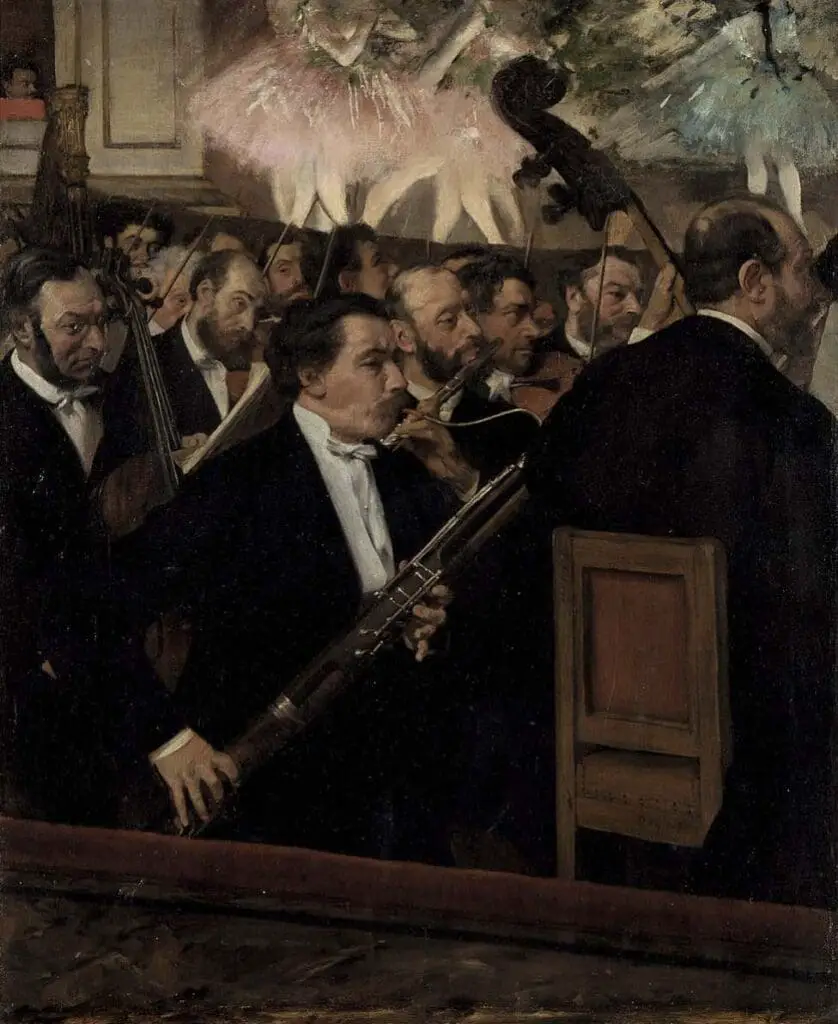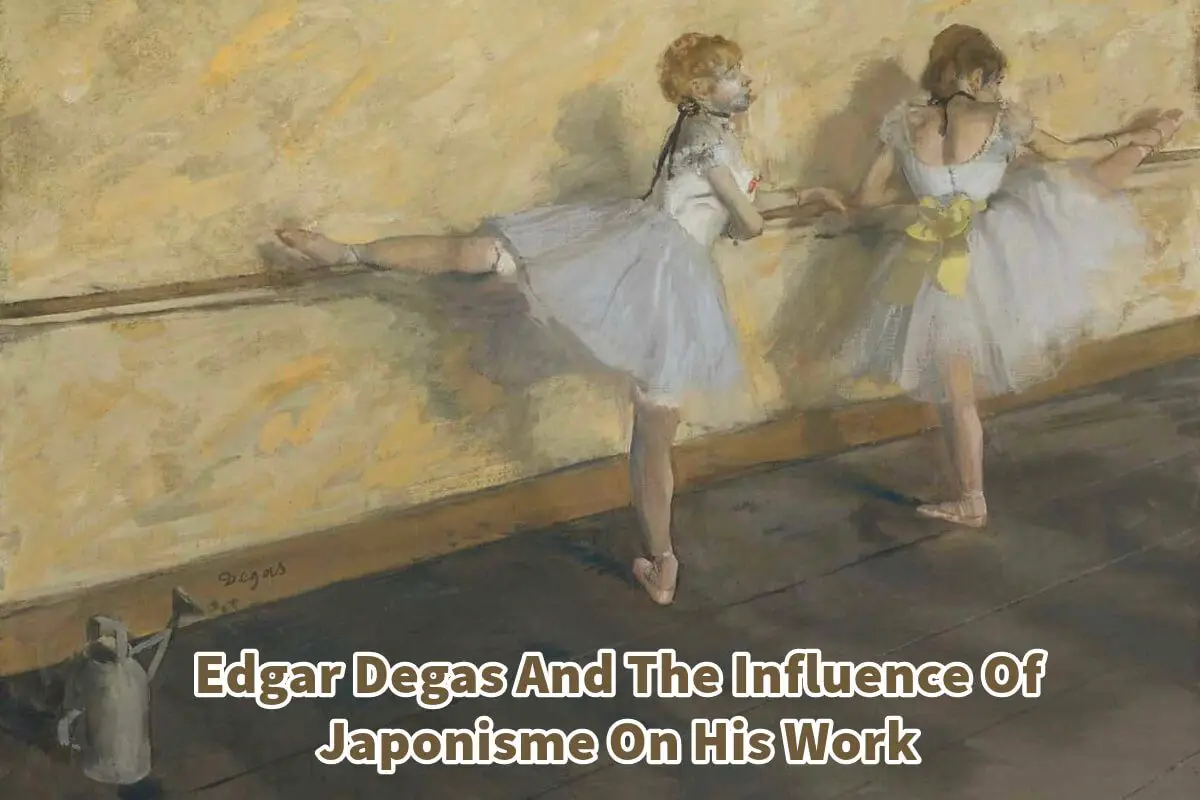I’ve always admired Japanese art, particularly the Ukiyo-e genre, known for its woodblock prints. This era gave rise to many esteemed Japanese artists and had a significant global impact, even influencing Western art.
Edgar Degas was among the Western artists deeply inspired by this Japanese art form. His works bear a clear imprint of the aesthetics and techniques he absorbed from Japanese Ukiyo-e masters. Read on; we delve into how his exposure to Japanese artistry shaped Degas’s art and examine some of his works that display this definitive influence.
Table of Contents
- Edgar Degas And The Influence Of Japonisme On His Work
- Degas’s “Dancers Practicing At The Barre”
- The Art Of The Everyday: “Woman Combing Her Hair”
- Eastern Perspectives In “The Orchestra At The Opera”
- Kitagawa Utamaro’s Influence
- Frequently Asked Questions
- Related Questions
Edgar Degas And The Influence Of Japonisme On His Work
The art world experienced a significant shift during the late 19th century, as artists from the West increasingly looked toward the East for inspiration. Japonisme, a term coined in 1872 by French art critic Philippe Burty, was a movement that encapsulated this enchantment with Japanese art and culture.
Edgar Degas, a seminal figure in the Impressionist movement, was deeply influenced by this trend. Notably, elements of Japonisme found their way into his groundbreaking works depicting scenes from modern life, including ballet dancers, laundresses, and musicians.
The Allure Of The East: Japonisme
Japonism emerged in France in the mid-19th century following Japan’s opening to foreign trade. Japanese art, mainly woodblock prints, caught the imagination of artists like Vincent van Gogh, Claude Monet, and Edgar Degas.
These prints were characterized by their distinctive compositions, flat color planes, and a focus on everyday scenes.
Degas’s “Dancers Practicing At The Barre”

A fascinating example of Degas’s engagement with Japonisme can be seen in his “Dancers Practicing at the Barre” (1877). Here, Degas moves away from the centralized compositions commonly found in academic paintings, instead adopting an asymmetric design.
Much like the “Willows and Bridge” painting from Japan, Degas employs diagonal solid lines that pull the viewer’s eyes across the canvas, highlighting the dynamic nature of the dancers’ stretching poses.
“Dancers Practicing at the Barre” also shares its muted color palette with Japanese works. The colors echo those found in Japanese folding screens like “Willows and Bridge,” using muted yellow, orange, green, and blue tones.

The painting captures the moment, a trait true to Impressionism but borrowed from the spontaneity often found in Japanese art.
The Art Of The Everyday: “Woman Combing Her Hair”
Another compelling example is Degas’s “Woman Combing Her Hair” (ca. 1888-90). The painting portrays an intimate moment: a woman engrossed in the simple task of combing her hair. Degas positions the viewer almost voyeuristically close, reminiscent of the intimacy in Japanese woodblock prints like Utagawa Hiroshige’s “Yamauba Combing Her Hair and Kintoki.
Both paintings share compositional techniques that make the ordinary appear extraordinary, allowing the viewer to contemplate the human figure performing everyday tasks.
The play of shadows and light in “Woman Combing Her Hair” showcases Degas’s Impressionist brushwork. It also subtly brings attention to the woman’s back and the shadows that form around it, which appear smooth despite the hurried strokes.
This delicate interplay of technique can be contrasted with Hiroshige’s work, where the lines depicting the body and hair are thin and delicate, lending a similar intimate effect.
Eastern Perspectives In “The Orchestra At The Opera”

Before he was famous for his ballerina paintings, Degas had a penchant for painting musicians. In “The Orchestra at the Opera” (1870), Degas adapts Eastern influences like a muted color scheme and a tightly cropped composition, creating a sense of immediacy and intimacy.
His incorporation of diagonal solid lines, a technique seen in Japanese art, guides the viewer’s gaze from one musician to another, all the way to the ballerinas on stage.
Kitagawa Utamaro’s Influence
Japanese artists also profoundly impacted Degas’s use of perspective and cropping. Kitagawa Utamaro’s “Two Women Under an Umbrella” provides another reference point for Degas. The strong diagonal created by the umbrella and the women exemplifies a bold compositional choice that broke away from traditional perspectives.

This tendency toward unconventional framing can be seen in numerous works by Degas, adding to the sense of immediacy and modernity that he was so keen on capturing.
The confluence of Eastern and Western ideas in the late 19th century was a wellspring of inspiration for many artists. For Edgar Degas, the incorporation of Japonisme into his work manifested through bold compositions, intimacy, and an innovative approach to capturing everyday life.
His engagement with Japanese art gave him an expanded toolbox of techniques and perspectives that enriched his contributions to art history. Far from a superficial or exoticizing engagement,
Degas’s experience with Japonisme was a mutually enriching cultural exchange, allowing him to transcend traditional Western artistic norms while paying homage to the distinct aesthetic virtues of Japanese art.
Thus, it’s evident that although deeply rooted in the Impressionist tradition, Degas’s work gained nuanced layers by incorporating Eastern influences. These influences helped solidify Degas as an artist not confined to one tradition or school but as a global artist receptive to cross-cultural dialogues.
Anita Louise Art is dedicated to art education, great artists, and inspiring others to find and create their art. We love art that uplifts and aspires. #ArtToMakeYouSmile! #ArtToMakeYouHappy!
If you want to see any of my art, you can find out more by clicking here. If you are interested in what inspires me and my paintings, you can discover more by clicking here.
We have a free newsletter and would love you to be part of our community; you can subscribe to the newsletter by clicking here. If you have any questions, I would be happy to talk to you. You can reach me, Anita, by clicking here.
Subscribe to our Anita Louise Art YouTube Channel filled with great videos and information by clicking here.
Join us for our podcast “5 Minutes With Art.” Spend just 5 minutes a week with us to discover and learn about great art and artists. You can find out more about our podcast by clicking here.
Frequently Asked Questions
What is Japonisme, and how did it influence Western art during Edgar Degas’s time?
Japonisme refers to the Western fascination with Japanese art and culture in the 19th century. It had a profound impact on Western art, introducing new aesthetic elements and techniques that artists like Degas incorporated into their work.
How did Edgar Degas first encounter Japanese art, particularly Ukiyo-e prints?
Degas was exposed to Japanese art through the influx of Ukiyo-e prints in Paris during the late 19th century. The opening of trade between Japan and the West allowed these prints to reach European artists, including Degas.
What aspects of Japanese Ukiyo-e art fascinated Edgar Degas the most?
Degas was particularly drawn to the composition, use of color, and depictions of everyday life in Ukiyo-e prints. He admired the flattened perspectives, bold colors, and dynamic scenes that characterized Japanese prints.
In what ways did Japonisme manifest in Edgar Degas’s artistic techniques and style?
Degas incorporated Japanese influences into his compositions, adopting flattened perspectives, asymmetrical compositions, and unusual cropping of figures. His use of color and the emphasis on capturing fleeting moments also reflect Japanese aesthetics.
Can you provide examples of specific Degas works that clearly showcase the influence of Japonisme?
Works such as “The Ballet Class” and “At the Races” exemplify Degas’s assimilation of Japanese aesthetics. These paintings reveal flattened perspectives, unconventional angles, and a focus on capturing transient moments akin to Ukiyo-e prints.
How did Japonisme contribute to the evolution of Degas’s depiction of movement in his artworks?
The influence of Japanese prints contributed to Degas’s exploration of unconventional angles and dynamic compositions, allowing him to capture the essence of movement and energy in his depictions of dancers and horse races.
Were there any challenges or criticisms that Degas faced for incorporating Japanese elements into his art?
Some contemporary critics questioned Degas’s departure from traditional Western artistic norms. However, over time, his innovative approach and incorporation of Japonisme became widely appreciated.
Did Edgar Degas ever engage with Japanese artists or directly study in Japan?
No, Degas never traveled to Japan or studied directly with Japanese artists. His exposure to Japanese art was primarily through the prints that reached Europe during the late 19th century.
How did Degas’s interest in Japonisme align with the broader artistic movements of his time, such as Impressionism?
Degas was associated with the Impressionist movement, which also embraced innovative techniques and a departure from traditional artistic conventions. His interest in Japonisme aligned with the broader spirit of experimentation and exploration within the Impressionist circle.
Did Degas’s fascination with Japanese art influence other artists of his time?
Yes, Degas’s interest in Japonisme had a ripple effect on other Western artists, influencing the likes of Mary Cassatt and Vincent van Gogh. The broader impact of Japanese art on Western aesthetics continued to resonate well into the 20th century.
Related Questions
Similarities Of Expressionism And Impressionism Art And Their Differences
Impressionism and Expressionism art movements started in Europe, but the Impressionism movement started before the Expression art movement. Each movement has different looks of art, which are distinguishable. Even though they are both different art movements, there are still some similarities.
By clicking here, you can learn more by reading Similarities Of Expressionism And Impressionism Art And Their Differences.
What Are The Main Characteristics Of Minimalism Art?
Minimalism art started in New York City in the 1960s. The minimalist artist would use limit their use of lines, shapes, and colors in their art. The artwork had no trace of the artist’s emotions in the art. Minimalism art is considered an extreme form of abstract art. The most important geometric shapes in minimalism art are the square and rectangle.
You can discover more by reading What Are The Main Characteristics Of Minimalism Art? by clicking here.
What Are The Characteristics Of The Arts And Crafts Movement?
The Arts and Craft Movement started in Britain and swept Europe and the United States. The movement started to become both popular and very influential in the late 19th century and changed how many artists worldwide viewed their art. It also changed how artists saw the design of not just their artwork but also buildings, fabrics, wallpaper, parks, cities, and objects in their homes and offices.
You can learn more by reading What Are The Characteristics Of The Arts And Crafts Movement? by clicking here.

